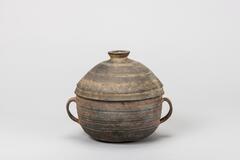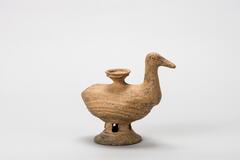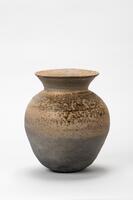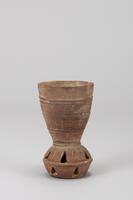41 UMMA Objects
41 UMMA Objects
![It has a outward-turned rim. The side of the body is becoming narrow in the base. The bottem is flat.<br />
<br />
This yellowish brown, bowl-shaped, low-fired earthenware vessel is made from fine clay mixed with fine sand particles. It has no neck. The mouth is slightly everted while the rim is generally flat and features some grooves. The body is widest towards the upper-middle section, and the flat base is rounded where it joins the body. Parts of the vessel feature a paddled pattern which suggests that the surface was first paddled and then smoothed with water on a rotary device.<br />
[Korean Collection, University of Michigan Museum of Art (2017) p. 44]<br />
It has a outward-turned rim. The side of the body is becoming narrow in the base. The bottem is flat.<br />
<br />
This yellowish brown, bowl-shaped, low-fired earthenware vessel is made from fine clay mixed with fine sand particles. It has no neck. The mouth is slightly everted while the rim is generally flat and features some grooves. The body is widest towards the upper-middle section, and the flat base is rounded where it joins the body. Parts of the vessel feature a paddled pattern which suggests that the surface was first paddled and then smoothed with water on a rotary device.<br />
[Korean Collection, University of Michigan Museum of Art (2017) p. 44]<br />
](/media/W1siZiIsIjIwMjIvMDkvMjQvNjVoNTM5eGtxal9kZWZhdWx0LmpwZyJdLFsicCIsInRodW1iIiwiMjQweDIwMCJdXQ?sha=d9e7c69efc7a919f)
Korean (Korean (culture or style))
Bowl with flat bottom and flat rolled rim
300 – 499
Gift of Bruce and Inta Hasenkamp and Museum purchase made possible by Elder and Mrs. Sang-Yong Nam
2004/1.160

Korean (Korean (culture or style))
Storage Jar on cut-out pedestal foot
500 – 699
Gift of Bruce and Inta Hasenkamp and Museum purchase made possible by Elder and Mrs. Sang-Yong Nam
2004/1.174
![The gray jar with a little long neck has a foot with rectangular perforations and is potted with fine silt-based clay. The relatively thin mouth is slightly everted. Three deep incisions encircle the midsection of the neck. The globular body is decorated with two incised line encircled the body. The foot whose bottom is rolled outward is a little high and wide.<br />
<br />
The long and splayed neck of this blue-gray, high-fired stoneware jar is encircled by two sets of ridges. The set on the upper section of the neck has two ridges, and the set on the lower section has one ridge. The rim is narrow and round. The inner surface of the neck shows rough, uneven surfaces resulting from wheel throwing. The body is widest at its middle. The vessel surface has been smoothed by paring on a wheel after attaching the low pedestal. The pedestal shows six rectangular perforations.
<p>[Korean Collection, University of Michigan Museum of Art (2017) p. 51]</p>
The gray jar with a little long neck has a foot with rectangular perforations and is potted with fine silt-based clay. The relatively thin mouth is slightly everted. Three deep incisions encircle the midsection of the neck. The globular body is decorated with two incised line encircled the body. The foot whose bottom is rolled outward is a little high and wide.<br />
<br />
The long and splayed neck of this blue-gray, high-fired stoneware jar is encircled by two sets of ridges. The set on the upper section of the neck has two ridges, and the set on the lower section has one ridge. The rim is narrow and round. The inner surface of the neck shows rough, uneven surfaces resulting from wheel throwing. The body is widest at its middle. The vessel surface has been smoothed by paring on a wheel after attaching the low pedestal. The pedestal shows six rectangular perforations.
<p>[Korean Collection, University of Michigan Museum of Art (2017) p. 51]</p>](/media/W1siZiIsIjIwMjIvMDkvMjQvMWNyMzV3bGVrZ19kZWZhdWx0LmpwZyJdLFsicCIsInRodW1iIiwiMjQweDIwMCJdXQ?sha=7b00061238459019)
Korean (Korean (culture or style))
Storage Jar on cut-out pedestal foot
400 – 599
Gift of Bruce and Inta Hasenkamp and Museum purchase made possible by Elder and Mrs. Sang-Yong Nam
2004/1.176

Korean (Korean (culture or style))
Two-handled bowl with cover
400 – 599
Gift of Bruce and Inta Hasenkamp and Museum purchase made possible by Elder and Mrs. Sang-Yong Nam
2004/1.182A&B

Korean (Korean (culture or style))
Vessel in the shape of a duck
200 – 399
Gift of Bruce and Inta Hasenkamp and Museum purchase made possible by Elder and Mrs. Sang-Yong Nam
2004/1.188
![It has a flat base, globular body and straight neck. There was a bubbling of the clay surface during firing. The attached handle is a little small and thick.<br />
<br />
This is a yellowish gray, low-fired earthenware cup with a handle. The mouth is upright, while the rest of the body has a swollen belly and a round base. The handle attached to the lower middle section of the body is not functional. Traces of rotation and water smoothing are visible on the inner and outer surfaces of the mouth.
<p>[Korean Collection, University of Michigan Museum of Art (2017) p. 68]</p>
<br />
It has a flat base, globular body and straight neck. There was a bubbling of the clay surface during firing. The attached handle is a little small and thick.<br />
<br />
This is a yellowish gray, low-fired earthenware cup with a handle. The mouth is upright, while the rest of the body has a swollen belly and a round base. The handle attached to the lower middle section of the body is not functional. Traces of rotation and water smoothing are visible on the inner and outer surfaces of the mouth.
<p>[Korean Collection, University of Michigan Museum of Art (2017) p. 68]</p>
<br />
](/media/W1siZiIsIjIwMjIvMDkvMjQvMWQybmE1M3FtYl9kZWZhdWx0LmpwZyJdLFsicCIsInRodW1iIiwiMjQweDIwMCJdXQ?sha=618fba87ddd6f364)
Korean (Korean (culture or style))
Small Single-Handed Cup
5th century
Gift of Bruce and Inta Hasenkamp and Museum purchase made possible by Elder and Mrs. Sang-Yong Nam
2004/1.190
![A ceramic lid for a matching bowl. Outfitted with a small, round and tapered handle.<br />
<br />
This yellow, low-fired earthenware vessel consists of a body and a lid. It is made from fine clay mixed with a small amount of fine sand particles. Fine, incised horizontal lines run around the body. The gallery that supports the lid rests at a slight incline, and the vessel mouth slopes slightly inwards. The lower part of the body rapidly tapers inwards before joining the base, the center of which is indented. The lid features a low, flat knob. The round, upper part of the lid meets the lip at a slight angle.[Korean Collection, University of Michigan Museum of Art (2017) p. 45]<br />
A ceramic lid for a matching bowl. Outfitted with a small, round and tapered handle.<br />
<br />
This yellow, low-fired earthenware vessel consists of a body and a lid. It is made from fine clay mixed with a small amount of fine sand particles. Fine, incised horizontal lines run around the body. The gallery that supports the lid rests at a slight incline, and the vessel mouth slopes slightly inwards. The lower part of the body rapidly tapers inwards before joining the base, the center of which is indented. The lid features a low, flat knob. The round, upper part of the lid meets the lip at a slight angle.[Korean Collection, University of Michigan Museum of Art (2017) p. 45]<br />
](/media/W1siZiIsIjIwMjIvMDkvMjQvMm9nbHVzanppOF9kZWZhdWx0LmpwZyJdLFsicCIsInRodW1iIiwiMjQweDIwMCJdXQ?sha=88066081a177047d)
Korean (Korean (culture or style))
Lid for Bowl
400 – 599
Gift of Ok Ja Chang and the Chang Family
2009/2.75B
![This bright grayish-blue stoneware jar consists of a round base, globular body and long flaring neck. Narrow single ridges encircle the middle part of the neck, dividing it into four sections. Each section is engraved with a wave pattern. The shoulder doesn’t have any pattern.<br />
<br />
This is a blue-gray, long-necked, high-fired stoneware jar. The horizontal ridge on the upper part of the long vessel neck marks the boundary between the neck and its inwardly curved mouth. The mouth slopes inward and has a sharp edge. The neck is divided into four sections by three horizontal ridges spaced at equal intervals, and each section is decorated by a wave design rendered with a comb with approximately ten teeth. The jar is widest at its upper-middle part, and the base is round with a slightly recessed center.<br />
[Korean Collection, University of Michigan Museum of Art (2017) p. 47]<br />
This bright grayish-blue stoneware jar consists of a round base, globular body and long flaring neck. Narrow single ridges encircle the middle part of the neck, dividing it into four sections. Each section is engraved with a wave pattern. The shoulder doesn’t have any pattern.<br />
<br />
This is a blue-gray, long-necked, high-fired stoneware jar. The horizontal ridge on the upper part of the long vessel neck marks the boundary between the neck and its inwardly curved mouth. The mouth slopes inward and has a sharp edge. The neck is divided into four sections by three horizontal ridges spaced at equal intervals, and each section is decorated by a wave design rendered with a comb with approximately ten teeth. The jar is widest at its upper-middle part, and the base is round with a slightly recessed center.<br />
[Korean Collection, University of Michigan Museum of Art (2017) p. 47]<br />
](/media/W1siZiIsIjIwMjIvMDkvMjQvM2M4cmF2ZmJ5OV9kZWZhdWx0LmpwZyJdLFsicCIsInRodW1iIiwiMjQweDIwMCJdXQ?sha=62bb2075b9e5bebe)
Korean (Korean (culture or style))
Storage jar with bands of incised wavy patterns at neck; lid missing
5th century
Museum purchase made possible by the Margaret Watson Parker Art Collection Fund
2003/1.384
![Jar with a round base, short neck and flaring mouth. Fabric imprints and gently indented lines stretch across the round body of the jar.<br />
<br />
This is a blue-gray, round-bottomed, high-fired stoneware jar with a short neck. Its neck curves outwards towards a widely flared mouth. The edge of the rim is slightly round, and the inner surface of the mouth is flattened. The inner and outer surfaces of the neck show traces of rotation and water smoothing. The body is widest at its upper-middle section, while its surface has been decorated with shallow horizontal lines after the rendering of a dense lattice design. The upper part of the vessel shows traces of an erased paddled pattern, and there are cracks on the inside of the base.<br />
[Korean Collection, University of Michigan Museum of Art (2017) p. 46]<br />
<br />
Jar with a round base, short neck and flaring mouth. Fabric imprints and gently indented lines stretch across the round body of the jar.<br />
<br />
This is a blue-gray, round-bottomed, high-fired stoneware jar with a short neck. Its neck curves outwards towards a widely flared mouth. The edge of the rim is slightly round, and the inner surface of the mouth is flattened. The inner and outer surfaces of the neck show traces of rotation and water smoothing. The body is widest at its upper-middle section, while its surface has been decorated with shallow horizontal lines after the rendering of a dense lattice design. The upper part of the vessel shows traces of an erased paddled pattern, and there are cracks on the inside of the base.<br />
[Korean Collection, University of Michigan Museum of Art (2017) p. 46]<br />
<br />
](/media/W1siZiIsIjIwMjIvMDkvMjQvNXZuNHhlbGlycV9kZWZhdWx0LmpwZyJdLFsicCIsInRodW1iIiwiMjQweDIwMCJdXQ?sha=2742a4fafbb9e2dd)
Korean (Korean (culture or style))
Round-Bottomed Jar
200 – 399
Gift of Bruce and Inta Hasenkamp and Museum purchase made possible by Elder and Mrs. Sang-Yong Nam
2004/1.163

Korean (Korean (culture or style))
Cord-marked round-bottomed jar with wide, flared mouth
5th century
Gift of Bruce and Inta Hasenkamp and Museum purchase made possible by Elder and Mrs. Sang-Yong Nam
2004/1.166
![Flared base with rounded food storage bowl on top. The base is cut with evenly spaced rectangular holes. The lid is incised with a repeating herringbone, or dotted design. The know on the lid is the shape of a Buddhist canopy, or chattra.<br />
<br />
This is a dark blue-gray, high-fired stoneware lidded stem cup. The lid is crowned by a pearl-shaped knob, while both the inner and outer surfaces of lid have traces related to the attachment of the knob to the lid. A v-shaped pattern of engraved dots, made using a sixtooth comb, surrounds the central knob. The cup’s flange slopes inwards and has a sharp edge. The cup body has a horizontal gallery that holds the lid in place. The stem is perforated by rectangular openings, below which is a sharply protruding circular raised band. Traces of rotation and water smoothing are visible on the body and stem of the cup.
<p>[Korean Collection, University of Michigan Museum of Art (2017) p. 59]</p>
Flared base with rounded food storage bowl on top. The base is cut with evenly spaced rectangular holes. The lid is incised with a repeating herringbone, or dotted design. The know on the lid is the shape of a Buddhist canopy, or chattra.<br />
<br />
This is a dark blue-gray, high-fired stoneware lidded stem cup. The lid is crowned by a pearl-shaped knob, while both the inner and outer surfaces of lid have traces related to the attachment of the knob to the lid. A v-shaped pattern of engraved dots, made using a sixtooth comb, surrounds the central knob. The cup’s flange slopes inwards and has a sharp edge. The cup body has a horizontal gallery that holds the lid in place. The stem is perforated by rectangular openings, below which is a sharply protruding circular raised band. Traces of rotation and water smoothing are visible on the body and stem of the cup.
<p>[Korean Collection, University of Michigan Museum of Art (2017) p. 59]</p>](/media/W1siZiIsIjIwMjIvMDkvMjQvOTRoajlpcWRqbV9kZWZhdWx0LmpwZyJdLFsicCIsInRodW1iIiwiMjQweDIwMCJdXQ?sha=27b6314c0d4219a2)
Korean (Korean (culture or style))
Pedestal Bowl with Cover
5th century
Gift of Bruce and Inta Hasenkamp and Museum purchase made possible by Elder and Mrs. Sang-Yong Nam
2004/1.169A&B

Korean (Korean (culture or style))
Bell Cup (goblet with rattle base)
5th century
Gift of Bruce and Inta Hasenkamp and Museum purchase made possible by Elder and Mrs. Sang-Yong Nam
2004/1.170
Loading…
